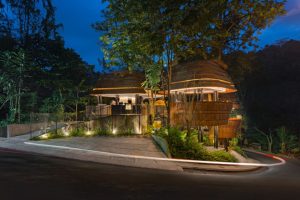Discussion of Indonesian Vernacular Architecture – Vernacular architecture is one of the many architectural styles that exist in the world. Vernacular architecture is a local architectural or construction style that utilizes traditional materials from nature or the environment around the building location.
Discussion of Indonesian Vernacular Architecture
vmiredetstva – The form of buildings in vernacular architecture is also adjusted to natural conditions, geographical factors, and the traditions of the people who inhabit the building. Therefore, vernacular architectural buildings from each region have their own uniqueness that makes them part of the cultural identity of the people of that region.
Some of the world-famous vernacular architectural buildings include stone houses in Iran, ice houses or igloos in the polar regions, Somba or Tammari houses in Africa, and many other examples. All of these building designs have the same characteristics, namely they are made of materials that are easily found around the location of the building.
These buildings were also not created by professional architects, but by the local community through mutual cooperation without formal architectural knowledge. Fundamentally, vernacular architecture emerged because of the human need to take shelter from the weather using materials available in the surrounding area, so that vernacular architectural buildings were adjusted to the climate in that place.
Read Also : Model dan Desain Rumah Minimalis Populer
Indonesian Vernacular Architecture
The diversity of Indonesian tribes and cultures brings richness to Indonesian vernacular architecture. From Sumatra Island to Papua, each region has its own distinctive vernacular architectural works.
Some examples of Indonesian vernacular architectural designs include the Rumah Gadang from West Sumatra which is famous for its grandeur, the beautiful Tongkonan Traditional House in Sulawesi, and the unique Honai House in Papua. In addition, Javanese vernacular architecture and Balinese vernacular architecture are no less rich in their diversity.
Balinese vernacular architecture features a tiered roof design and uses straw for the roof, coconut wood, bamboo, and stone as the main materials. Balinese vernacular architecture is dominated by Hindu influences, which can be found in temple buildings, entrance gates, and adapted in modern buildings such as hotels, restaurants, and tourist attractions.
In modern times, the principles of Indonesian vernacular architecture are certainly very interesting to discuss and apply. Moreover, currently green architecture or architectural works built with environmental conservation principles are increasingly being applied by architects to balance the increasingly concerning condition of the earth.
Read Also : Latest and Trendy Types of Women’s Clothing
Buildings based on Indonesian vernacular architecture prioritize the use of materials available in the surrounding area, thus reducing carbon emissions from the material transportation process. Large windows and open building concepts in buildings with Indonesian vernacular architectural style will also save on electricity usage because the house is already cool enough with good air circulation.
Javanese Neo Vernacular Architecture
The adaptation of Indonesian vernacular architecture into today’s buildings has resulted in a new concept called neo vernacular architecture. In addition to implementing green architecture, neo vernacular architecture also aims to display elements of culture or local wisdom of a region with a modern appearance.
Neo vernacular architectural buildings are easily found in various existing structures. Among the public buildings that carry the neo vernacular architectural style are Terminal 1 and Terminal 2 of Soekarno-Hatta International Airport and the Grand Mosque of West Sumatra.
On the island of Java, you can easily see Javanese neo vernacular architectural works applied to buildings and houses. One of the most striking characteristics of Javanese neo vernacular architecture is its unique roof shape. There are several roof designs that are characteristic of Javanese vernacular architecture, such as the Panggang Pe, Kampung, Limasan, Joglo, and Tajug roofs.
Getting to Know Indonesian Vernacular Architecture
Neo-vernacular architecture also adapts vernacular architectural elements from other regions in Indonesia, such as the horn-like roof that is characteristic of Minangkabau, the colorful ornaments of traditional houses in Toba, North Sumatra, and the concept of traditional stilt houses typical of Kalimantan, and others.
Other Articles: Do You Want to Design a Traditional-Themed House in the Middle of the City? Here’s How!

